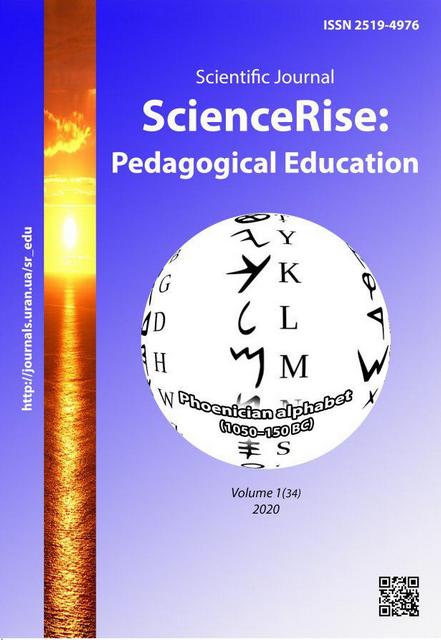Practical aspects of using the model of the competitiveness development management system
DOI:
https://doi.org/10.15587/2519-4984.2020.193192Keywords:
management of competitive development of GSEI, factor-criterion submodel, object of management, management criteriaAbstract
The practical aspect of using the model of management system of development of competitiveness of a general secondary education institution is considered in the article. The prospects of using pedagogical qualimetry as a structural element of managing the competitiveness of an institution of general secondary education are analyzed, the main directions of the use of pedagogical qualimetry and ensuring its competitiveness in the internal and external markets of education, research of the state and tendencies of development of the educational process through the factor submodel are analyzed. The stages of the pedagogical experiment are analyzed. The explanation for the researcher at the ascertaining, forming and control stages of the experiment is given.
Management objects are identified: educational process; marketing; financial and economic activities; innovativeness of management system and educational technologies; organizational and corporate culture; strategic and managerial component; logistical and technological support of the educational process; staff competitiveness, which need to be directed by management actions in order to ensure a high level of competitiveness of a general secondary education institution. It is noted, that certain management units in their totality are a certain integrated quality of competitiveness of a general secondary education institution.
Criteria for the controls of objects are developed. In determining the weight of these criteria, the method of expert determination of the weights is applied. In order to calculate the coefficient of competitiveness of a General Secondary Education Institution, a survey was conducted among experts and a weighted average of each expert group was rounded to one.
The characteristics of four levels (high, sufficient, middle and low) of competitiveness of an institution of general secondary education are formed on the basis of the factor-criterion model, as well as by means of combination of quantitative and descriptive approaches
References
- Monakhov, V. M. (2001). Pedagogicheskoe proektirovanie – sovremennii instrumentarii didakticheskikh issledovanii. Shkolnye tekhnologi, 5, 75–89.
- Riabova, Z. V., Yermolenko, A. B., Makhynia, T. A. et. al.; Oliinyk, V. V., Frekh, F. (Eds.) (2016). Proektnyi menedzhment dlia innovatsiinoho rozvytku osvitnikh orhanizatsii Ukrainy. Kyiv: KulturKontakt Avstriia, 118.
- Kyrychuk, V. O., Hontarovska, N. B., Prashko, O. V., Androsovych, K. A., Melnyk, M. Yu., Veselka, Yu. B.; Kyrychuk, V. O. (Ed.) (2014). Sotsialno-pedahohichne proektuvannia rozvytku obdarovanosti uchnia v systemi navchalno-vykhovnoho protsesu. Kyiv: Instytut obdarovanoi dytyny, 192.
- Khutorskoi, A. V. (2005). Tekhnologiia proektirovaniia kliuchevykh i predmetnykh kompetencii. Eidos. Available at: http://www.eidos.ru/journal/2005/1212.htm
- Klymenko, S. M., Omelianenko, T. V., Barabas, D. O., Dubrova, O. S., Vakulenko, A. V. (2008). Upravlinnia konkurentospromozhnistiu pidpryiemstva. Kyiv: KNEU, 520.
- Maslov, V. I., Bodnar, O. S., Horash, K. V. (2012). Naukovi osnovy ta tekhnolohii kompetentnoho upravlinnia zahalnoosvitnim navchalnym zakladom. Ternopil: Krok, 320.
- Trethowan, D. (1991). Managing with Appraisal Achieving Quality Schools through Performance Management. London, 248.
- Iiyoshi, T., VijayKumar, M. S. (Eds.) (2008). Opening up education: the collective advancement of education through opentechnology, open content, and open knowledge. MIT Press, 477.
- Nychkalo, N. H., Molchanova, A. O., Klokar, N. I., Kyrychenko, M. O., Oliinyk, V. V., Otych, O. M. et. al.; Kyrychenko, M. O., Serheieva, L. M. (Eds.) (2018). Vidkryta osvita: innovatsiini tekhnolohii ta menedzhment. Kyiv: Vyd-vo In-tu obdar. dytyny NAPN Ukrainy, 440.
- Astratova, G. V. (Ed.) (2014). Kvalimetriia: metody kolichestvennogo ocenivaniia kachestva razlichnykh obektov. Surgut: RIO SurGPU, 160.
- Riabova, Z. V. (2004). Monitorynh rozvytku navchalnoi diialnosti uchniv 6-7 richnoho viku (upravlinskyi aspekt). Kyiv, 27.
- Litkevych, A. M. (2019). Modeliuvannia upravlinnia konkurentospromozhnistiu zakladu zahalnoi serednoi osvity. Teoriia ta metodyka upravlinnia osvitoiu, I (22). Available at: http://umo.edu.ua/images/content/nashi_vydanya/metod_upr_osvit/v_22/%D0%9Bi%D1%82%D0%BA%D0%B5%D0%B2%D0%B8%D1%87.pdf
- Panasenko, E. (2011). Zmist i struktura eksperymentu yak metodu naukovoho doslidzhennia u teorii ta praktytsi vitchyznianoi pedahohiky (1945–1991 rr.). Ridna shkola, 11, 28–35.
- Pedahohichnyi eksperyment (2008). Kirovohrad: Vydavnytstvo KOIPPO imeni Vasylia Sukhomlynskoho, 72.
- Puzikov, D. O. (2014). Kvalimetrychna faktorno-kryterialna model otsiniuvannia innovatsiinoho rozvytku zahalnoosvitnoho navchalnoho zakladu. Aktualni problemy sotsiolohii, psykholohii, pedahohiky, 4 (25), 226–234.
- Hryhorash, V. V. (2014). Kvalimetrychnyi pidkhid do ekspertnoho otsiniuvannia navchalno-vykhovnoho protsesu. Pedahohika formuvannia tvorchoi osobystosti u vyshchii i zahalnoosvitnii shkolakh, 34 (87), 140–146.
- Dmytrenko, H. A., Anufriieva, O. L., Burlaienko, T. I., Medvid, V. V. (2016). Kvalimetriia v upravlinni: humanistychnyi kontekst. Zhytomyr: Vydavets O. O. Yevenok, 336.
- Bobrovskyi, M. V., Horbachov, S. I., Zaplotynska, O. O. (2019). Rekomendatsii do pobudovy vnutrishnoi systemy zabezpechennia yakosti osvity u zakladi zahalnoi serednoi osvity. Kyiv: Derzhavna sluzhba yakosti osvity, 240.
Downloads
Published
How to Cite
Issue
Section
License
Copyright (c) 2020 Alla Litkevych

This work is licensed under a Creative Commons Attribution 4.0 International License.
Our journal abides by the Creative Commons CC BY copyright rights and permissions for open access journals.
Authors, who are published in this journal, agree to the following conditions:
1. The authors reserve the right to authorship of the work and pass the first publication right of this work to the journal under the terms of a Creative Commons CC BY, which allows others to freely distribute the published research with the obligatory reference to the authors of the original work and the first publication of the work in this journal.
2. The authors have the right to conclude separate supplement agreements that relate to non-exclusive work distribution in the form in which it has been published by the journal (for example, to upload the work to the online storage of the journal or publish it as part of a monograph), provided that the reference to the first publication of the work in this journal is included.








